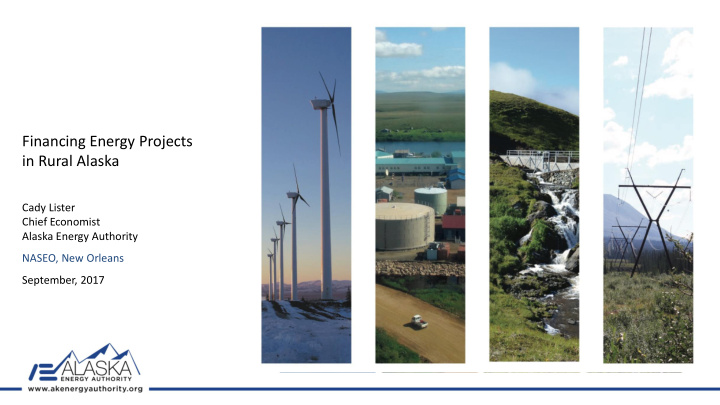



Financing Energy Projects in Rural Alaska Cady Lister Chief Economist Alaska Energy Authority NASEO, New Orleans September, 2017
AEA’s mission is to reduce the cost of energy in Alaska 2
AEA takes a community- centered approach with: • Technical assistance • Energy planning • Resource assessment • Project identification • Funding • Training • O&M Perryville, AK 3
A ssistance with project development, financing, and long- term management of energy infrastructure • Diesel powerhouses • Heat Recovery • Bulk Fuel • Power Cost Equalization • RE (wind, bio, hydro, solar) • End-use efficiency Quinhagak, AK 4
Alaska Energy Authority invests in rural Alaska $257 million in Renewable Energy Fund since 2008 $11 million in Emerging Energy Technology Fund since 2010 Kodiak, AK 5
Alaska Energy Authority invests in rural Alaska $350 million in Bulk Fuel Upgrades since 2000 $250 million in Rural Powerhouse Upgrades since 2000 Akutan, AK 6
Alaska: by the numbers 740,000 People 660,000 Sq. Miles 200 Remote Microgrids 7
Railbelt 72% of Pop 76% of Energy (Natural Gas) Southeast 10% of Pop 13% of Energy Rest of AK 18% of Pop 11% of Energy 8
Rural AK pays a high cost of energy Venetie, AK (energy prices from 1/5/17) 9
Rural infrastructure 10
Rural infrastructure 11
Diesel is primary power in 90% of rural Alaska Shaktoolik, AK 12
Integrating renewables 13
What works elsewhere doesn’t necessarily work here Sand Point, AK 14
The future points to dynamic project funding the future 2017 Need remains constant Yet availability of public funding to help meet that need is decreasing 15
AEA’s Project Development & Finance Team • First point of contact for accessing the full breadth of AEA’s technology, project management and financing expertise • Identifying good projects, building on planning and technical assistance • Assisting communities in navigating complex systems, e.g. federal funding requirements, regulatory, permitting, etc. • Identifying and accessing funding options for utilities and communities 16
Technical Assistance – Identifying Good Projects Critical Technology Areas Evaluating Options • End-use Efficiency • Resource assessment • Hydro • Comparing technologies • Biomass • Energy planning and coordination • Wind • Utility/customers/community impacts • Heat Recovery • Project implementation management • Diesel generation/integration 17
Technical Assistance – Accessing Funding External to Utility Funds Internal to Utility Funds • Research grant opportunities • Reporting to optimize PCE • Assist with grant application • Rate setting to cover all costs development • Evaluation of project financial • Research loan opportunities impacts • Assist with loan application • Utility business practice to development improve financial health • Administer PPF program 18
The Power Project Fund Loan Program • Flexible loan program • Covers all aspects of supply side system • Available for all project dev. phases • Technical, economic and finance viability • Increased interest and activity recently • Anticipate activity will continue to grow Waterfall Creek Construction Healy, AK 2
What we know about rural community financing needs: 1. Alaska’s small , isolated communities bring many challenges to project development 2. Access to financing is not the primary barrier for projects, though it is a significant one 3. Communities need more than just “green” energy projects 4. Alaska’s regulatory environment offers few requirements or incentives to spur private investments 5. There is no effective financing model to capitalize on the significant opportunity for cost reduction through efficiency improvements 20
Alaska Affordable Energy Strategy Recommendation: Community Energy Fund for Alaska (CEFA) • Focus initially on community-scale financing needs • Use existing resources to create “Energy Investment Partnerships” ✓ State: Power Project Loan Fund, Alaska Housing Finance Corporation, PCE, other loans/grants ✓ Denali Commission and other granting entities ✓ Other financial institutions: CDFIs, banks, credit unions, USDA • One-stop-shop: The state would take on administrative responsibility, some credit risk, and provide incentives, e.g. loan guarantees and loan-loss reserves from state or non-state sources • Use grants as incentives and to mitigate rate shock • Reduces, but does not eliminate, long-term subsidy and capital grants 21
CEFA Phase 1: Set up loan & agreements State $ Utility Vendor(s) Infrastructure Granting entity 22
CEFA Phase 2: Initial payback of loan State (PPF) Utility Customers Rates P Granting entity C E State (PCE) 23
CEFA Phase 3: Recapitalize loan fund Financial State Sell part of loan Institution (PPF) Enhanced interest rate Guarantee Granting entity 24
Proposed Loan Product Example Financial State FI share of loan $ Institution (PPF) Rates Utility Customers Granting PCE entity State (PCE) 25
Benefits of central mixed financing • Reduce need for state grants • Leverage non-state funds more effectively • Create direct and indirect incentives for improving infrastructure maintenance • Ensure minimal impact on rates • Potential to expand into other markets 26
27
ALASKA ENERGY AUTHORITY 813 West Northern Lights Blvd. Anchorage, Alaska 99503 Phone: (907) 771-3000 Fax: (907) 771-3044 Toll Free (Alaska Only) 888-300-8534 AEA’s mission: Reduce the cost of energy in Alaska. 28
Recommend
More recommend